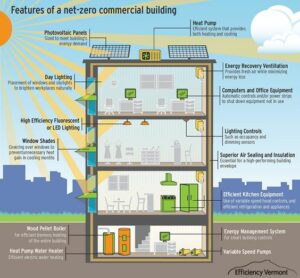The current use of the term “zero energy building” may make it sound like a building literally has zero energy consumption but in reality, a net zero energy building is one which produces as much energy as it uses over the course of a year.
What are Net Zero Energy Buildings?
Most Net Zero Energy Buildings (NZEB) are still connected to the electric grid, allowing for the electricity produced from traditional energy sources (natural gas, electric, etc.) to be used when renewable energy generation cannot meet the building’s energy load. Conversely, when on-site energy generation exceeds the building energy requirements, the surplus energy should be exported back to the utility grid, where allowed by law. The excess energy production offsets later periods of excess demand, resulting in a net energy consumption of zero.

Most Net Zero Energy Buildings (NZEB) are still connected to the electric grid, allowing for the electricity produced from traditional energy sources (natural gas, electric, etc.) to be used when renewable energy generation cannot meet the building’s energy load. Conversely, when on-site energy generation exceeds the building energy requirements, the surplus energy should be exported back to the utility grid, where allowed by law. The excess energy production offsets later periods of excess demand, resulting in a net energy consumption of zero.
What is the goal of Net Zero Energy Building?
The goal in creating such buildings is to contribute less overall greenhouse gas to the atmosphere during operations. Regardless of the definition or metric used for a Net Zero Energy Building, however, minimizing the energy use through efficient building design should be a fundamental design criterion in all new building projects.
Energy Efficiency and Net Zero Energy Buildings
Energy efficiency is generally the most cost-effective strategy with the highest return on investment, and maximizing efficiency opportunities before developing renewable energy plans will minimize the cost of the renewable energy projects needed. Using advanced energy analysis tools, design teams can optimize efficient designs and technologies.
Energy efficiency measures include design strategies and features that reduce the demand-side loads such as:
- High-performance Envelope: The building envelope is made up of many different components: roof, walls, windows, doors, etc. The building envelope acts as a thermal barrier, playing an important role in regulating interior temperatures and determining the amount of energy required for optimal thermal comfort. Creating a high-performance building envelope means each piece is designed to minimize the transfer of thermal energy in both directions. This decreases cooling loads during summer and heating loads during New constructions provide the best opportunity to deploy a high-performance building envelope, since it can be built into the project.
- Air Barrier Systems: The basic function of an air barrier system is to prevent uncontrolled air leakage through the building enclosure. An air barrier must be a complete system of materials and components that work together to truly provide a continuous barrier to air flow
- Daylighting: Daylighting is the practice of placing windows, skylights, other openings, and reflective surfaces so that sunlight can provide effective internal lighting, reducing the amount of energy needed for heating and cooling. The process of daylighting also includes controlling how much natural light(both diffuse and direct) enters a building and is generally accompanied by lighting control systems that are responsive to the amount of daylight entering the building.
- Passive Solar Heating: These systems collect heat as the sun shines through south-facing windows and retains it in materials that store heat. For example, greenhouses and sunrooms are examples of passive designs. The sun’s rays pass through the windows, and the structure’s interior absorbs and retains the heat.
Once building loads are reduced, the loads should be met with efficient equipment and systems. This may include:
- Energy efficient lighting: Energy-efficient CFL or LED lighting fixtures offer some substantial advantages over traditional lighting. Not only do these lights use less energy to light the same area as incandescent or traditional fluorescent lights, but in most cases they give off less heat. This reduces the need to cool the building in the warmer months. No matter how energy efficient a lighting system is, the energy is being wasted if no one needs it. Consider occupancy sensors which can help prevent light and energy from being wasted.
- Cooling Optimization: Chilled water can account for up to 35% of HVAC energy costs. Optimization solutions very in their approach but work to produce this chilled water more efficiently. tekWorx Xpress® solutions continuously adjust equipment sequences and key setpoints based on parameters related to process requirements and outdoor air temperature. This ensures maximum system efficiency in real‐time while maintaining cooling requirements at the lowest total kW per ton.
- Geothermal Heat Pumps: Also known as the ground source heat pump, this technology relies on the fact that the earth (beneath the surface) remains at a relatively constant temperature throughout the year, warmer than the air above it during the winter and cooler in the summer. The geothermal heat pump takes advantage of this by transferring heat stored in the earth or in ground water into a building during the winter and transferring it out of the building and back into the ground during the summer.
With more than 40% of CO2 emissions coming from buildings, and an average of 30% of building’s energy being wasted annually, focus needs to shift to the way buildings are being designed, built, operated and maintained. New advancements in technology, however, are making it easier to create net zero energy buildings which are not only more energy efficient and sustainable but can also produce renewable energy.




